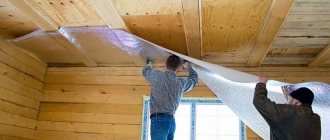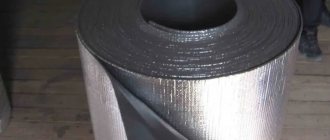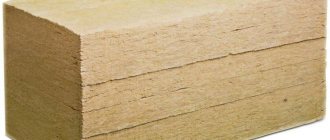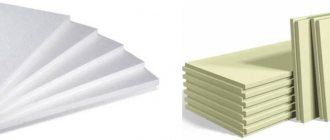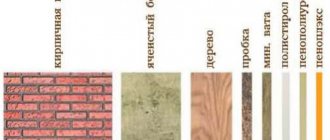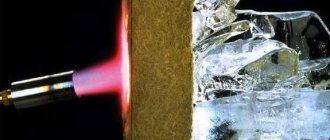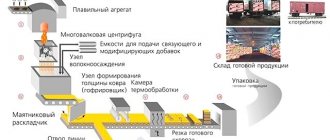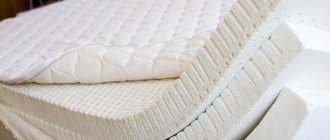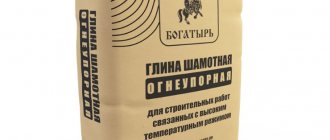Savig
4403 0 0
Savig November 15, 2017Specialization: master of interior finishing works. I am well versed in power tools for repair and construction. Formerly a teacher at a radio engineering college.
Foil-coated isolon has a very wide range of exploitation
Don't know which thermal insulation material to choose? I propose to consider folgoizol in this capacity. This insulation is specially manufactured in such a way as to perform its functions for a long time and in the most unfavorable conditions. But let's talk about everything in more detail.
What is folgoizol
Folgoizol is a polyethylene with a cellular structure, coated with a thin layer that reflects heat radiation on one or both sides. Elastic fabric with a porous structure is environmentally friendly and is characterized by a wide range of properties:
- does not get wet, is a vapor barrier;
- protects against environmental factors;
- does not allow impact noise to pass through, dampens sounds;
- retains most of the thermal radiation.
A unique synthetic material, it is used in many areas; protection of utility networks, utility structures, and roofing coverings is indispensable without it. Insulation with foil insulation creates a double barrier against heat loss:
- the object is isolated from contacts with the cooling external environment;
- The metallized coating layer prevents heat leakage.
The top layer, similar to corrugated aluminum foil, is resistant to rotting, corrosion, and protects against ultraviolet radiation. The production of folgoizol is based on the use of the latest technologies based on physical and chemical processes.
Insulation and waterproofing material folgoizol
The structure of porous polyethylene is often modified - particles are connected at the molecular level, forming cross-links (the so-called cross-linking process). Hydrogen atoms are separated in given chains to connect the necessary links.
Thanks to cross-linking, the density and, accordingly, the strength of the porous material increases, thermal conductivity decreases, and the level of moisture absorption decreases. In general, resistance to the influence of aggressive substances, noise absorption increases, and the service life becomes longer.
As a result of using various production methods, types of polyethylene foam are obtained:
- PPE, or cross-linked;
- NPE, or uncrosslinked.
The so-called “cross-linking” process is carried out using chemical and physical methods to achieve the required performance qualities. Non-crosslinked porous polyethylene foam, characterized by the smallest number of internal bonds, is inferior in quality indicators to the second type of foil insulation.
But the affordable price of this modification maintains a steady demand for products obtained as a result of less complex production. A variety of NPE comes with a self-adhesive base, of different densities and heights.
Due to its elasticity, foil polyethylene foam is easy to lay on any surface. For convenience, the insulator is produced in the form of sheets, rolls, and sleeves. The service life is approximately 20 years.
Protective shells
This class includes foil insulation of the SRF and ACC brands. In essence, it is reinforced aluminum foil, which is used as a protective shell for the thermal insulation layer of pipelines and containers.
Folgoizol SRF is a corrugated aluminum foil 100 or 200 microns thick, reinforced with fiberglass.
The material is used for external covering, and acts like a thermos, reflecting thermal energy towards radiation.
That is, it prevents heat supply networks from cooling down and the pipes of cooling systems from heating up. In addition, such a shell protects external communications and containers from exposure to the sun during the hot season. The material is not subject to corrosion and decay under the influence of ultraviolet radiation, and is absolutely vapor and waterproof.
Foil insulation ACC 2x2 and ACC 5x5 are smooth aluminum foil reinforced with fiberglass mesh with a cell of 2x2 mm or 5x5 mm. The scope and advantages are the same as those of the SRF.
Recommendations for use:
- Protective shells work on the principle of a thermos and reflective thermal insulation, so there must be a layer of at least 20 mm thick between the wall of the pipe or container.
- Filling the layer is possible with any type of thermal insulation materials: mineral wool, PPS or PPU shells, sprayed PPU, foam rubber, etc.
- Massive soft and hard thermal insulation shells are fixed with wire, steel or polymer tape ties.
- Foil insulation is laid on top and secured in the same way as massive thermal insulation. Laying in strips or segments is carried out with an overlap of at least 5 cm.
Properties and characteristics
The typical structure of the material, including porous polyethylene and aluminum foil, maintains stable thermal insulation properties. The polished surface with a reflective effect prevents heat loss.
Folgoizol contains no toxins, so coatings are used for interior work. There is no odor, contact with skin is safe. Foamed polyethylene, lightweight and tensile, not susceptible to moisture, has excellent sound insulation qualities.
Folgoizol consists of several layers
The performance characteristics of foil insulation are improved due to the coating with aluminum foil, which has a reflection effect. The safety of the fragile material is ensured by the application of a polypropylene film that is resistant to mechanical, acid-base effects, as well as petroleum products (gasoline, oil, fuel oil).
The porous structure helps reduce heat losses. In comparison with other materials (wood, mineral wool, expanded polystyrene), with the same height of the protective layer, foil insulation wins as the best sealant. The closed cell structure allows the advantage to be maintained even at low layer heights.
The softness and elasticity of the material contribute to the smooth finishing of any premises, parts of various shapes and sizes. Additional characteristics of folgoizol:
- light weight;
- resistance to the appearance of fungi, mold, microorganisms;
- melting point 107 - 130 ° C (moderately flammable material);
- long period of use;
- temperature range for operation -80° - +80°C.
It is worth considering that when exposed to an open fire, toxic products are released, and the degree of smoke formation is considered to be high. The lack of water absorption, reliable vapor and sound insulation make it possible to use foil insulation as a sealant for interfloor ceilings. The production of sheets of various heights determines the selection of insulator for a specific purpose.
The height of the porous layer is up to 1.5 cm, the foil coating is 0.01 - 1.0 mm. Standard size sheets are available in thicknesses of 3, 4, 5, 8, 10 mm. You can find sheets 1.5 cm high, 150 cm wide, 20 cm long. A roll of foil insulation has standard dimensions: width 1.5 m, length from 50 to 200 m.
The performance characteristics of the insulator, roofing and waterproofing grades are regulated by GOST. The material does not require special tools for processing; it is easily compatible with concrete, wood, lime, etc. The environmentally friendly coating is as easy as possible to use.
Folgoizol is sold and transported in rolls
Bitumen foil insulation
Bitumen foil insulation is produced in accordance with GOST 20429-84. Aluminum foil is used as the top layer. And it comes in two main types:
- FC - for installation and repair of flat roofs;
- FG - for creating protective coatings.
Features and composition
In addition to the general standard, each manufacturer has its own technical conditions, agreed upon in accordance with the established procedure. They describe the scope of application in more detail, add new subtypes, detail the labeling depending on the specific design, and provide recommendations for use.
Thus, protective coatings are used for:
- waterproofing of pipelines, metal containers and structures;
- waterproofing of brick structures and structures;
- waterproofing of concrete structures, including foundations, swimming pools, technical wells and tunnels;
- steam and waterproofing of enclosing vertical and horizontal structures made of wood, metal, reinforced concrete;
- creating waterproofing carpets over continuous sheathing for small-piece roofing on pitched roofs.
Based on the method of fixation to the protected surface (structure), two groups of materials are distinguished:
- surface-surfaced (FC, FG, TFP, HFP);
- self-adhesive (TFS, TFKS, HFKS).
In addition, products without aluminum foil are produced under this name. And, naturally, it does not have the letter F in its markings. These include rolled materials for installing the first layer of soft roofing. For example, from Promex LLC (Ekaterinburg):
- TPP/KhPP - weld-on grades;
- TPS/TSS - self-adhesive stamps.
Bitumen foil-isol has the following composition:
- base: fiberglass (marked with the letter T), fiberglass (X), polyester (E);
- binder: petroleum roofing or road bitumen;
- coating: aluminum foil, polymer film;
- separating layer for storage in rolls and transportation: polyethylene film or silicone-impregnated paper;
- fillers: crumb rubber, chrysolite asbestos;
- additives: synthetic rubbers, rosin, petroleum or coal oils.
General recommendations for use on roofs
The basis may be:
- reinforced concrete floor slabs with seams made of cement-sand mortar not lower than grade M150;
- cement screeds (M150 and above);
- asphalt concrete screeds (M80 and above);
- prefabricated screeds (asbestos cement slabs);
- profiled sheet for load-bearing floors;
- monolithic thermal insulation made of lightweight concrete;
- extruded polystyrene foam;
- solid wooden bases made of boards, moisture-resistant plywood or OSB3.
To create a vapor barrier layer, brands without foil are used, self-adhesive on one side or fused on both sides.
For slopes less than 10%, it is permissible to lay materials without gluing them to the base, but with gluing the seams. Laying is carried out with overlaps between adjacent canvases and when they are built up. The amount of overlap at the end is at least 150 mm, along the long side - 80-100 mm. The end overlaps of adjacent panels must be spaced at least 500 mm from each other.
The direction of laying sheets for roofs with a slope of less than 15% should be perpendicular to the direction of the slope. For roofs with a slope of more than 15%, laying the rolls parallel to the direction of the slope is allowed; in these cases, mechanical fastening of foil insulation is recommended in addition to fusing or gluing.
The total number of layers of a soft roof is determined at the roof design stage based on the design features and operating conditions, but there must be at least two.
Advantages and disadvantages
There are many advantages of foil insulation compared to other insulation materials:
- low weight allows you to do without metal profile lathing or mechanical fasteners, which greatly facilitates the installation process; the material is easy to lay and transport without special equipment;
- the cellular structure prevents the penetration of steam, sound and moisture, maintains excellent thermal insulation qualities;
- chemical inertness ensures compatibility with many building materials when insulating structures and equipment;
- ease of use opens up the possibility of insulating surfaces with your own hands, without resorting to the help of specialists or using complex tools;
- Convenience of cutting is ensured by the release form in rolls, mats, which are easy to unfold and can be cut with ordinary scissors;
- the cost-effectiveness of the material makes the insulator affordable;
- the elasticity of the canvas does not create a risk of tearing when bending during installation;
- The versatility of the coating ensures its use in both internal and external finishing works.
The disadvantages of foil insulation include the soft structure of the material, which makes it difficult to lay the insulation under the screed. The fabric is not suitable for covering high-temperature objects - gas boilers, chimneys due to the low melting point.
The material is not compatible with wallpaper, paint, or plaster finishes. You can cover the heat insulator with sheets or slabs of plastic panels, wooden slats, MDF, chipboard, fiberboard.
Folgoizol is used in roofing construction
Use of insulation with foil: get acquainted with the types and their names
When dealing with insulation problems when renovating an apartment, building a house, a bathhouse, other utility or utility buildings, any owner is always faced with the problem of choosing the optimal thermal insulation materials. It’s good that nowadays the range of them on sale is quite wide. But this variety of choices can also play a “wicked joke” on an ignorant person - it’s no wonder you get confused in such abundance and make a mistake. Therefore, when going to a store to make a purchase or planning to place an online order, the consumer should already have an idea of the characteristics of the material, its features, areas of application and basic installation techniques.
The use of insulation with foil
This article will review thermal insulation materials, which, despite the fact that they may have a different base, are still united by one common important feature - a foil surface. So, we consider the types, advantages and disadvantages, price level and practical application of insulation with foil.
Advantages and disadvantages of foil-lined insulation
Any of the insulating materials has its own insulating qualities due to the foamed, porous, fluffy, fibrous or other base, which allows you to create and retain a layer of air. Well, the air itself has extremely low thermal conductivity, and the total result is a thermal insulation layer, the transfer of thermal energy through which, if not completely excluded, is significantly reduced. It is clear that any material has its own thermal resistance indicators, and the general capabilities of the insulation also depend on its thickness.
Porous structure of conventional insulation materials
1 – mineral wool.
2 – foamed polyethylene.
3 – polystyrene foam.
4 – foamed concrete.
But this is, so to speak, a passive role of insulation. Is it possible to make sure that the thermal insulator not only does not allow heat to pass through its structure, but also participates more actively, reflecting thermal energy in the desired direction? It turns out that it is possible - and foiling is used for this.
The wavelength of infrared radiation is close to visible light, and the heat flux, just like a light beam, can be reflected from a mirror surface and redirected back. It is on this principle that any thermos works - a thin glass or metal flask for liquid with an internal mirror or polished surface, and an air (or vacuum) layer around it.
This is how the well-known thermos works
The heat in such a simple design is retained for a very long time. Exactly the same principle is used when insulating residential premises, baths, industrial buildings and technological lines, agricultural facilities, etc. For this purpose, foil insulation is used.
Modern technologies make it possible to apply a layer of aluminum foil to almost any thermal insulation material, so that the strength of the resulting multilayer structure is maintained, without its delamination. As a result, new insulation materials acquire a number of remarkable qualities:
- The created “thermos effect” in the room allows you to retain heat much better in winter, and vice versa - coolness in summer.
- Increasing the efficiency of thermal insulation entails reducing energy consumption for heating needs.
- The foil surface itself is a good barrier against the penetration of moisture and water vapor, which in some cases makes it possible to do without an additional waterproofing layer.
- Foil in no way reduces the thermal insulation properties of the material; on the contrary, it enhances them and allows the use of insulation materials of much smaller thickness, which is sometimes extremely important in tight spaces.
- Any type of foil insulation is also a good sound insulator.
- Applying foil to a thermal insulator does not pose any threat from an environmental point of view. On the contrary, it often becomes a strengthening barrier against the penetration of the smallest particles of material into the space of the room.
- The material is easy to install, which does not require any special professional skills. Moreover, it can, if necessary, be dismantled and then installed in the same or another place.
- The material is produced in rolls or panels, which is very convenient for installation work.
The disadvantages include the following:
- Aluminum is still subject to gradual corrosion, which is why it begins to become cloudy, and over time its reflective qualities weaken somewhat.
- The metal layer can become very hot, and therefore during installation it is necessary to provide a small air gap between the insulation and the surface finish. By the way, this same air gap will facilitate ventilation of the aluminum coating, and the absence of moisture on the surface of the foil will greatly reduce the aggressiveness of corrosion processes and thereby increase the service life of the material.
Prices for thermal insulation materials
Thermal insulation materials
Main types of insulation with foil
Now it’s worth considering in more detail the main types of foil insulation, their characteristic features and areas of application. In private construction, materials made from foamed polyethylene, mineral wool or expanded polystyrene are widely used. There are other materials, for example, basalt-fiber-based boards with foil, but this material is expensive and has a specific purpose - for thermal insulation of technological lines, power plants, special industrial facilities, etc.
Foil insulation based on polyethylene foam
This is one of the most common and easy-to-use types of foil insulation. It is a layer of polyethylene foamed using a special technology, covered with one or two layers of foil 10 ÷ 15 microns thick.
Structure of foil polyethylene foam
The thickness of the insulating layer can be different - from 2 to 15 mm. The release form is usually rolls, but there may also be sheets of a standardized size, which is especially typical for the thickest (15 mm) types.
One of the release forms is standard size sheets
Three types of material are available:
- type A – one-sided foiling;
- type B - foil is applied on both sides, which is sometimes required to enhance thermal insulation properties;
- type C - on one side there is foil, on the other there is a self-adhesive layer covered with a protective film, which, if necessary, facilitates the installation process on the ceiling or on vertical surfaces.
There may also be differences in the type of source material used:
- Inexpensive brands use ordinary NPE polyethylene, which is subjected to repeated foaming during the production process to create a closed gas-filled porous structure. The disadvantage of this material is its low resistance to deformation loads and the property of gradual shrinkage.
- The best performance is achieved by insulation based on specially treated, “cross-linked” polyethylene (PPE). Its density is slightly higher, but due to transverse intermolecular bonds it not only withstands mechanical stress better, but also tends to recreate its original shape after removing the dynamic load. When purchasing material, this nuance must be taken into account.
Some types of such insulation may additionally have a fiberglass reinforcing mesh in their structure.
Rolled material with clearly visible fiberglass mesh reinforcement
You can find many types of insulation based on polyethylene foam. Certified products of the brands “Penofol”, “Ekofol”, “Isoflex”, “Izolon”, “Jermaflex”, “Folgoizol” are deservedly popular. Some characteristics of these materials are shown in the table:
| Name of material | Penofol | Izolon | Ecofol | Isoflex |
| Miniature | ||||
| Thermal conductivity coefficient, W/m×°С | 0,049 | 0.04 | 0,049 | 0,035 |
| Density, kg/m³ | 35 | 26 ÷ 33 | 33 | 35 ÷ 45 |
| Thermal reflectivity | at least 90% | up to 95 ÷ 97% | at least 80% | at least 90% |
| Operating temperature range | from -60° to +100°С | from -80° to +80°С | from -60° to +90°С | from -60° to +80°С |
| Vapor permeability of the material, mg/m×h×Pa | 0,001 | 0,001 | 0,001 | 0,001 |
| Release form | Thickness 2, 4, 5, mm with a layer of foil 14 microns, rolls 1.2 × 30 m; thickness 8 and 10 mm – rolls 1.2 × 15 m | The width of the sheet is 1.5 m, the thickness is 2, 3, 4, 5, 8 and 10 mm, the length per roll is 200, 170, 130, 100, 80 and 50 m, respectively. Individual sheets are 15 mm thick, dimensions 1500 × 2000 mm | Rolls 1200 mm wide, insulation thickness 2, 3, 5, 8 and 10 mm, length 25 and 15 m. | Rolls are 1200 mm wide, insulation thickness is 2, 3, 5, 8 or 10 mm, length is 25 and 15 m. Foil thickness is 10 microns. |
Foil-coated polyethylene foam is widely used in repair and construction work. Sheets or strips of insulation are attached to the surface in any convenient way, but in such a way as to prevent a strong violation of the integrity of the foil (for example, it is permissible to fasten it using the staples of a construction stapler). As a rule, the canvases are laid end-to-end, which is then glued with foil tape to provide a single, seamless reflective and insulating surface.
It is recommended to seal the joints with foil tape
- Floor insulation. It is used as an additional or even main (for example, in multi-storey buildings) thermal insulation layer, which can simultaneously play the role of a waterproofing agent. It is laid with the foil side up before laying the final floor covering.
Floor insulation with foil polyethylene foam
- Thermal insulation and additional sound insulation of walls and ceilings, especially in conditions where the size of the room does not allow the use of thicker types of insulation (a classic example is a narrow balcony or loggia). Attached with the foil side facing the room. Be sure to provide a gap between the foil and the finishing coating (lining, panels, etc.). It is usually fixed to the surface with battens (counter battens), which become the basis for the cladding.
Thermal insulation material fixed to the walls
- Insulation of roof slopes. Can be used alone or in combination with other materials. In any case, the foil polyethylene foam is attached last towards the attic space, and the sheathing is mounted on top of it, maintaining a gap.
Polyethylene foam as an additional insulating layer on the roof
- Bathroom insulation. The foil layer simultaneously plays the role of a reliable vapor barrier, protecting the wall material from waterlogging. True, in steam room conditions, where there may be critically high temperatures, the use of the material is not always justified due to the limited temperature range of its operation.
Thermal reflective screen behind the radiator
- Thermal reflective screens behind heating radiators. This measure prevents thermal energy from being wasted on unnecessary heating of the external wall, redirecting the infrared flow back into the room.
The material is widely used for insulation and sound insulation of car interiors.
Interestingly, this material is widely used for other purposes not related to construction. Thus, it is excellent for insulating and soundproofing car interiors. It is also used to make warm insoles for winter shoes.
Video: comparative tests of insulation made of foil polyethylene foam
Mineral wool with foil
The thermal insulation properties of mineral wool are very high in themselves. But additional foil will only increase the efficiency of insulation. In addition, this material is very hygroscopic, and an additional barrier against the penetration of moisture and water vapor will not allow the mineral wool to get wet and lose its qualities.
Roll of foiled mineral wool
The material is produced in rolls, pre-compressed or sectional, or individual slabs.
| Name of insulation | ISOVER Sauna | Rockwool Sauna Butts | Knauf Insulation LMF AluR | PAROC |
| Miniature | ||||
| Thermal conductivity coefficient, W/m×°С | 0,041 | 0,036 | 0.04 | 0,039 |
| Density, kg/mm³ | 11 | 40 | 36 | 32 |
| Thickness | 50 or 100 mm | 50 or 100 m | 20 or 50 mm | 50 or 100 mm |
| Release form | Rolls are 1200 mm wide, 12.5 or 6.25 m long, with threefold compression of the material. | Packages of 10 or 5 slabs of mineral wool foil slabs with dimensions 1000 × 600 mm | Rolls 1000 mm wide, 10 or 5 m long | Mats 1200 × 600 mm or rolls up to 5 m |
Due to the fact that the upper operating temperature limit of mineral wool exceeds 300 degrees, it is ideally suited for insulating the surface of walls and ceilings in bathhouses. In principle, this is the main purpose of such foil insulation, although, of course, nothing prevents it from being used for other purposes, for example, for thermal insulation of the roof.
Insulation of the attic with foil-coated mineral wool
In any case, the slabs or mats are located between the sheathing guides. The pitch of the guides is initially set to 10 ÷ 20 mm less than the width of the insulation - so it will fit tightly into the niche intended for it. The density of the foil is usually such that the insulation can be secured with staples to the aluminum layer. The joints must be taped with foil tape in order to maintain the effect of water vapor barrier. An air gap of 20 ÷ 25 mm is left between the insulation and the wall (ceiling) sheathing.
Special insulation for pipelines
Mineral wool insulation is also available in the form of collapsible cylinders or half-cylinders - these products are excellent for thermal insulation of pipelines.
The heat resistance of mineral foil wool allows it to be used for additional thermal insulation of boilers, boilers, storage tanks, and other heating devices.
Prices for mineral wool
Mineral wool
Video: thermal insulation of a bathhouse with foil insulation “ISOVER Sauna”
Expanded polystyrene mats with foil
Not so often, but still another type of foil insulation is used. We are talking about slabs (mats) made of polystyrene foam with aluminum foil on one side.
Such products can be produced in single mats or in rolls of several meters, made in sections, like a tractor caterpillar.
Expanded polystyrene foil mat for heated floors
The main purpose of such insulating foil materials is thermal insulation of floors, both independently and in a “warm floor” system. A layer of aluminum foil reflects heat upward to warm the finish, so that expensive energy is not wasted heating massive floor slabs or subfloors laid on the ground.
To facilitate the process of laying the contours of a “warm floor”, most models of such mats have convenient, clearly visible markings. Fixing the pipes will not be particularly difficult - for this you can use special clamps with “harpoon” tips, which will reliably hold the element in the thickness of the polystyrene foam.
Fastening the “warm floor” pipe to the mat
It is better to purchase mats made from extruded polystyrene. Its increased density makes the material resistant to fairly significant mechanical loads, which is especially important when constructing floors.
To conclude this review, one very important remark must be made. All of the listed advantages of foil insulation will be valid only if the material is of high quality. The fact is that some unscrupulous manufacturers limit themselves to applying a thin aluminized coating. This is far from foiling, although the materials may be similar in appearance. A thin sprayed layer is not able to adequately reflect the heat flow - infrared radiation will mostly pass through it. And such a “decorative” shiny layer will also not become a barrier to the penetration of moisture and water vapor.
Application of folgoizol
A unique waterproofing material is in demand in various fields:
- tourism - in the manufacture of equipment, sports equipment;
- mechanical engineering – for noise and waterproofing of car showrooms;
- shipbuilding - in the production of swimming vests, surface fencing means.
In industry, the use of foil insulation is associated with the reliable transportation of valuable equipment, packaging of instruments, and fragile products. The insulator is called indispensable during construction work:
- for hydro- and thermal insulation of foundations, construction of interfloor ceilings - foil insulation for the floor is used as a base for screed using the dry method. The height, medium or large, is selected taking into account the specifics of installation - on a soil base, wooden beams;
- for laying the finishing coating - a good soundproofing sealant as a substrate for the floor, dampens impact noise, muffles the sounds of walking, hides surface unevenness. The thickness of the foil insulation is selected taking into account the dynamic loads on the finishing coating for a shock absorption effect;
- for wall insulation - the use of foil insulation increases the efficiency of thermal protection of external walls. The moisture resistance of the coating allows the use of foil insulation material for baths and other buildings with internal humidity;
- to protect the roof - laying an insulator under corrugated sheets, metal tiles, and other corrugated material reduces the level of extraneous noise and increases energy saving;
- for thermal insulation of communications - the elasticity of the insulator allows the material to be attached to pipeline sections, which reduces heat loss.
Many apartment owners line their balconies with foil insulation to retain heat. It should be noted that you first need to think through a system that generates heat, for example, a “warm floor,” and then ensure its conservation.
Main technical indicators of the material:
- The production of foil insulation is based on foil with a thickness of 100 microns (at the request of the customer it can be up to 200 microns);
- the material has a long service life, which is up to twenty years;
- is not subject to decay and corrosion under the influence of the external environment, as well as ultraviolet radiation;
- folgoizol can be used in various temperature conditions - ranging from minus 60 to plus 170 degrees.
Insulation and insulation with foil insulation is most popular at present, since aluminum foil, which is the main component, creates excellent water and vapor barrier. Optimal waterproofing is created thanks to the waterproof properties of the material.
Folgoizol is a material that does not ignite, does not smolder, does not emit harmful substances, is not afraid of moisture and has a long service life, so it is widely used from the northern latitudes of our country to its southern regions. Due to its environmental properties, this material began to be actively used in the food industry.
Using this material many problems were solved:
- the service life of pipelines has increased due to their complete protection against corrosion;
- heat loss on heating mains has decreased;
- safety requirements for maintaining temperature conditions are fully complied with;
- In the event of an emergency water shutdown in winter, freezing of water in the pipes is prevented.
Folgoizol is easy to install; it can be used to cover any surface, since its main component is corrugated foil. It has been practically proven that with the use of high-quality insulation of heating mains and water pipelines, not only their service life is extended to the maximum, but also the energy spent on heating the premises is significantly saved, which is important in our modern conditions.
Installation features
Plates, sections of rolls, and sheets of insulation cannot be overlapped. The material is secured with nails or construction staples. During installation, joints must be taped with foil tape to avoid thermal leaks. The insufficient rigidity of foil insulation causes some installation features:
- laying on vertical or horizontal surfaces is carried out by gluing an insulating layer;
- soft material is enclosed in a lathing made of wood or metal profiles.
Self-adhesive foil insulation does not need to be fixed with reinforced fasteners, but to increase the service life it is better to attach the heat insulator with small nails. If there is no adhesive coating for fixation, it is recommended to use an adhesive composition.
You can glue foil insulation with foil tape
How to glue
When working with foil insulation, you can’t do without
- small nails;
- construction stapler;
- hammer;
- foil-coated tape.
Important! Installation is carried out by fastening the foil insulation in such a way that the side with the foil is directed inward, as a result of which the surface reflects thermal radiation from heating sources. Placing it on the wrong side will not achieve the desired effect.
Before gluing foil insulation , the surface must first be cleaned of dirt, traces of mold, and wallpaper residues. Large debris particles can damage the polyethylene foam, which will reduce the quality of thermal protection. It is recommended to treat the base with antiseptic agents, without which the fixation of the insulator will be unreliable.
Areas of use
The use of folgoizol is very diverse. Here are just some of the most popular examples:
- For the bath. It speeds up the heating of the steam room due to the fact that it returns the thermal radiation of the stove back into the room. Moisture resistance also plays a role, without which not a single insulating material will last long in a steam room;
Finishing the bathhouse with foil insulation will increase its efficiency
- As roofing insulation . This is lightweight insulation, which means that even the flimsiest roof will withstand it. In addition, they can provide thermal insulation both from the inside and outside of the structure;
- For heated floors . It fits under the system and allows you to redirect the heat generated by the heating elements from the ground into the room.
Price and reviews
On the construction market, the range of foil insulation includes many types of heat insulator. The cost of the material is influenced by the main indicators:
- height of the polyethylene foam layer, reflective film;
- the presence of foil coating on one or both sides;
- release forms (mats, sheets, rolls);
- manufacturing technologies;
- manufacturer's brands.
The price of foil insulation in online stores may differ from the cost in a building materials supermarket. The following brands of insulator are available for sale:
- TFP-3.5 – in rolls of 10 m², 2161 rubles;
- KHMAP-3.5 – in rolls of 10 m², 1391 rubles;
- HFS 1.5-20 – in rolls of 15 m², 3060 rub.
Before purchasing a heat insulator, it is useful to study consumer comments posted on review sites. For example, buyers share their experience of using foil insulation to place it behind the radiators of an apartment in a panel multi-storey building, where it is quite cool in winter. The silver heat reflector retains heated air, as a result of which it increases the temperature in the room by 3-4 degrees.
On forum sites, experienced builders advise beginners on the adequate selection of foil insulation brand for roof insulation, flooring, sealing of floors, finishing of vertical surfaces, taking into account the specifics of the building’s heating, building materials, availability of ventilation and other factors. The activity of users in discussing brands and quality of foil insulation confirms the demand for heat insulation.
